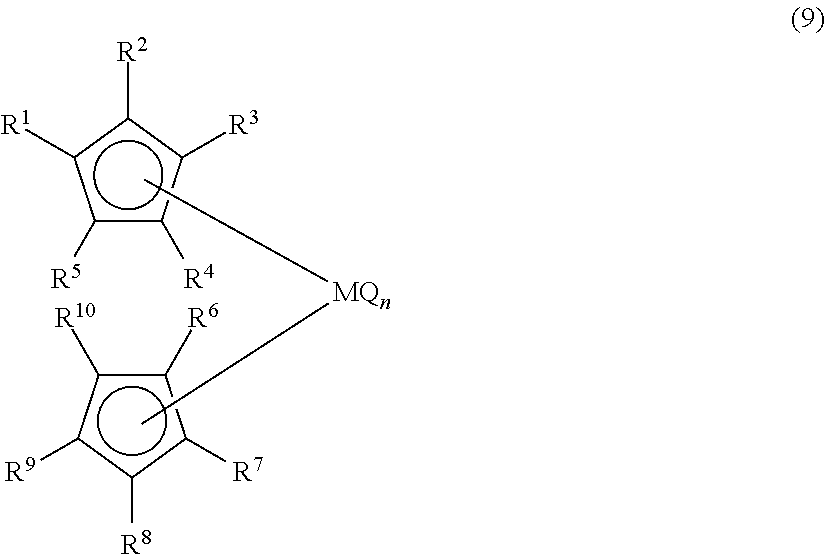Process for preparing organic alkali metal compound and organic transition metal compound
a technology of transition metal and organic alkali metal, which is applied in the field of preparation organic transition metal compound, can solve the problems of low activity in the polymerization reaction, inability to stabilize the resulting metallocene compound, and high risk of organic alkali metal compound to achieve the effect of high yield and safe preparation
- Summary
- Abstract
- Description
- Claims
- Application Information
AI Technical Summary
Benefits of technology
Problems solved by technology
Method used
Image
Examples
preparation example 1
Preparation of 5-tert-butyl-1,1,3-trimethyl-1,2-dihydropentalene
[0075]In a 1000 ml five neck flask, 24.97 g (204 mmol) of tert-butylcyclopentadiene and 399.04 g of acetone were placed. In an ice water bath, 82.1 g (1.15 mol) of pyrolydine was dropwise added, followed by stirring for 18 hours under reflux. In an ice water bath, 70.91 g (1.18 mol) of acetic acid was dropwise added. From the resulting crude product, the solvent was distilled off under reduced pressure (150 torr, 40° C.), and the resulting product was washed with water, a 5% acetic acid solution, a saturated sodium hydrogen carbonate aqueous solution and a saturated saline solution, followed by drying over magnesium sulfate. After the solvent was distilled off, the remainder was purified by vacuum distillation, whereby 23.4 g of 5-tert-butyl-1,1,3-trimethyl-1,2-dihydropentalene represented by the following formula [1] was obtained. Identification was carried out by a 1H-NMR spectrum and a GC-mass spectrometry spectrum (...
preparation example 2
Preparation of 9-(5-tert-butyl-1,1,3-trimethyl-1,2-dihydropentalenyl)-1,1,4,4,7,7,10,10-octamethyl-octahydro-dibenzo[b,h]fluorene
[0079]In 100 ml three neck flask, 1.58 g (4.09 mmol) of 1,1,4,4,7,7,10,10-octamethyl-octahydro-dibenzo[b,h]fluorene and 30 ml of tert-butyl methyl ether were placed. In an ice / acetone bath, 2.7 ml (4.2 mmol) of a 1.56Mn-butyllithium hexane solution was dropwise added. With slowly raising the temperature up to room temperature, the mixture was stirred for 25 hours.
[0080]Then, a tert-butyl methyl ether solution containing 0.95 g (4.30 mmol) of 5-tert-butyl-1,1,3-trimethyl-1,2-dihydropentalene was added, followed by stirring for 16 hours under reflux. Thereafter, the reaction solution was poured into 1N hydrochloric acid. The organic layer was separated and washed with a saturated sodium hydrogencarbonate aqueous solution, water and a saturated saline solution. The resulting product was dried over magnesium sulfate, and the solvent was distilled off. The resu...
example 1
Preparation of [9-(5-tert-butyl-1,1,3-trimethyl-1,2-dihydropentalenyl)-1,1,4,4,7,7,10,10-octamethyl-octahydro-dibenzo[b,h]fluorenyl]dilithium
[0083]In a 30 ml Schlenk flask, 1.18 g (2.01 mmol) of 9-(5-tert-butyl-1,1,3-trimethyl-1,2-dihydropentalenyl)-1,1,4,4,7,7,10,10-octamethyl-octahydro-dibenzo[b,h]fluorene, 0.485 g (4.10 mmol) of α-methylstyrene, 13.5 g of hexane and 2.35 ml (20.2 mmol) of cyclopentyl methyl ether were placed. Then, 2.55 ml (4.21 mmol) of a 1.65M n-butyllithium hexane solution was dropwise added at 26° C., and the mixture was stirred at 70° C. for 3.5 hours, whereby a solution of [9-(5-tert-butyl-1,1,3-trimethyl-1,2-dihydropentalenyl)-1,1,4,4,7,7,10,10-octamethyl-octahydro-dibenzo[b,h]fluorenyl]dilithium was obtained.
[0084]The reaction solution was added to methanol-d4 (available from Acrose Co., deuteration ratio: 100%) to deuterate the resulting dilithium salt. After the solvent was distilled off from the resulting solution, the solid precipitated was extracted ...
PUM
| Property | Measurement | Unit |
|---|---|---|
| valence | aaaaa | aaaaa |
| organic | aaaaa | aaaaa |
| metallic | aaaaa | aaaaa |
Abstract
Description
Claims
Application Information
 Login to View More
Login to View More - R&D
- Intellectual Property
- Life Sciences
- Materials
- Tech Scout
- Unparalleled Data Quality
- Higher Quality Content
- 60% Fewer Hallucinations
Browse by: Latest US Patents, China's latest patents, Technical Efficacy Thesaurus, Application Domain, Technology Topic, Popular Technical Reports.
© 2025 PatSnap. All rights reserved.Legal|Privacy policy|Modern Slavery Act Transparency Statement|Sitemap|About US| Contact US: help@patsnap.com



